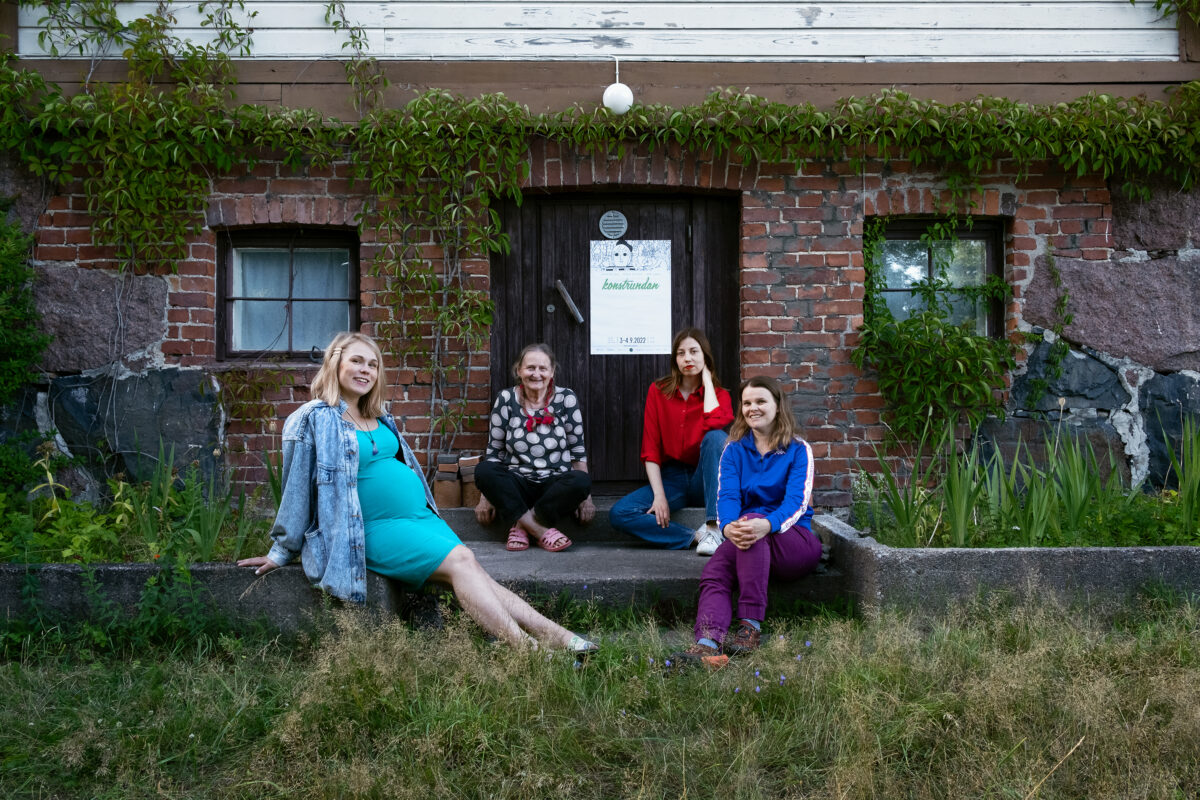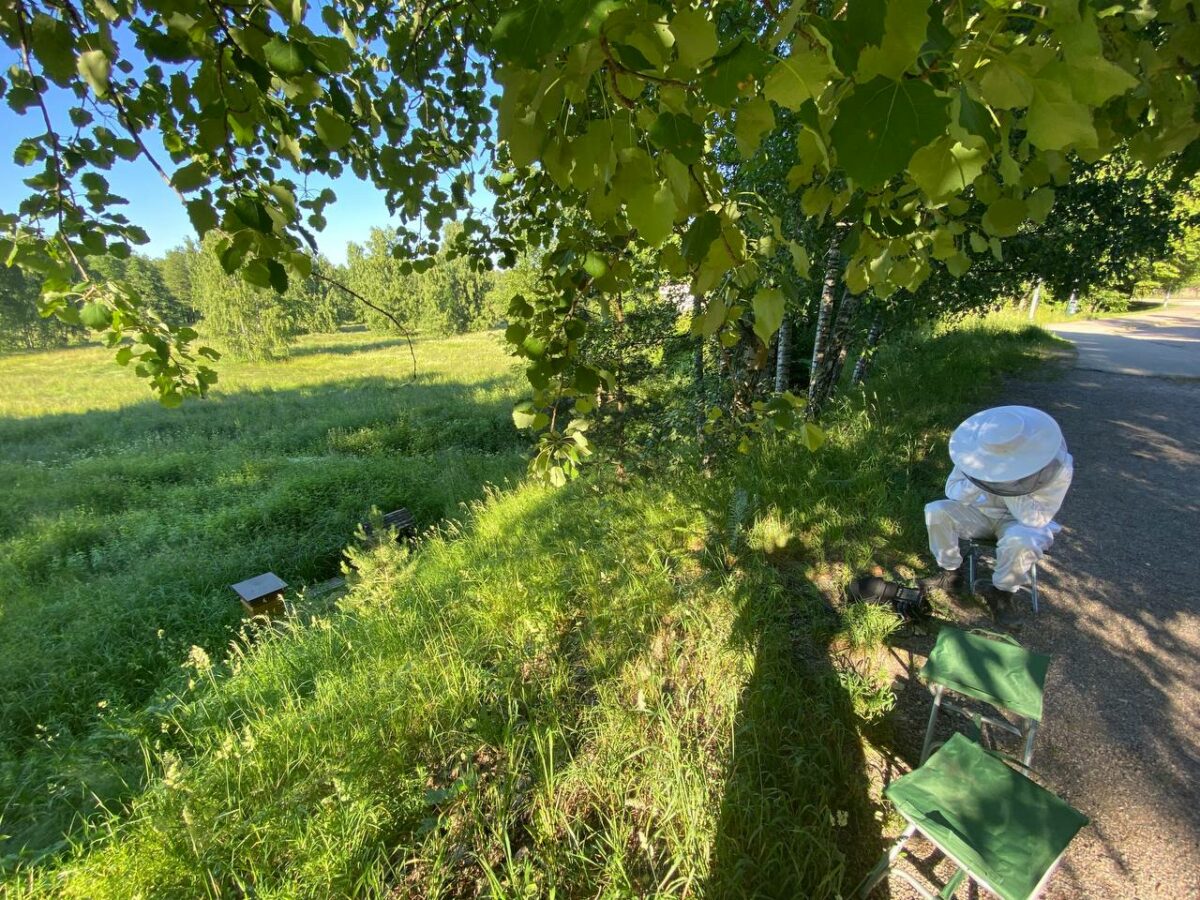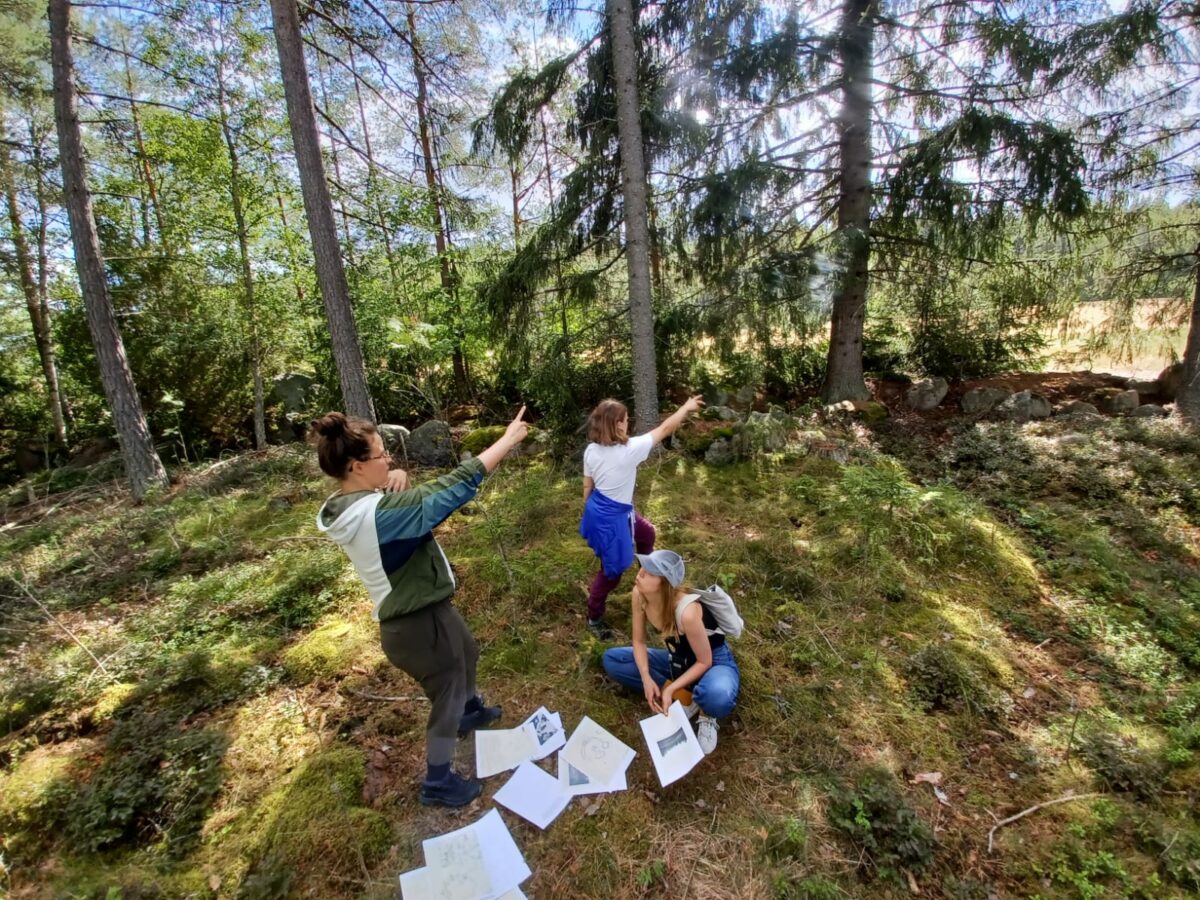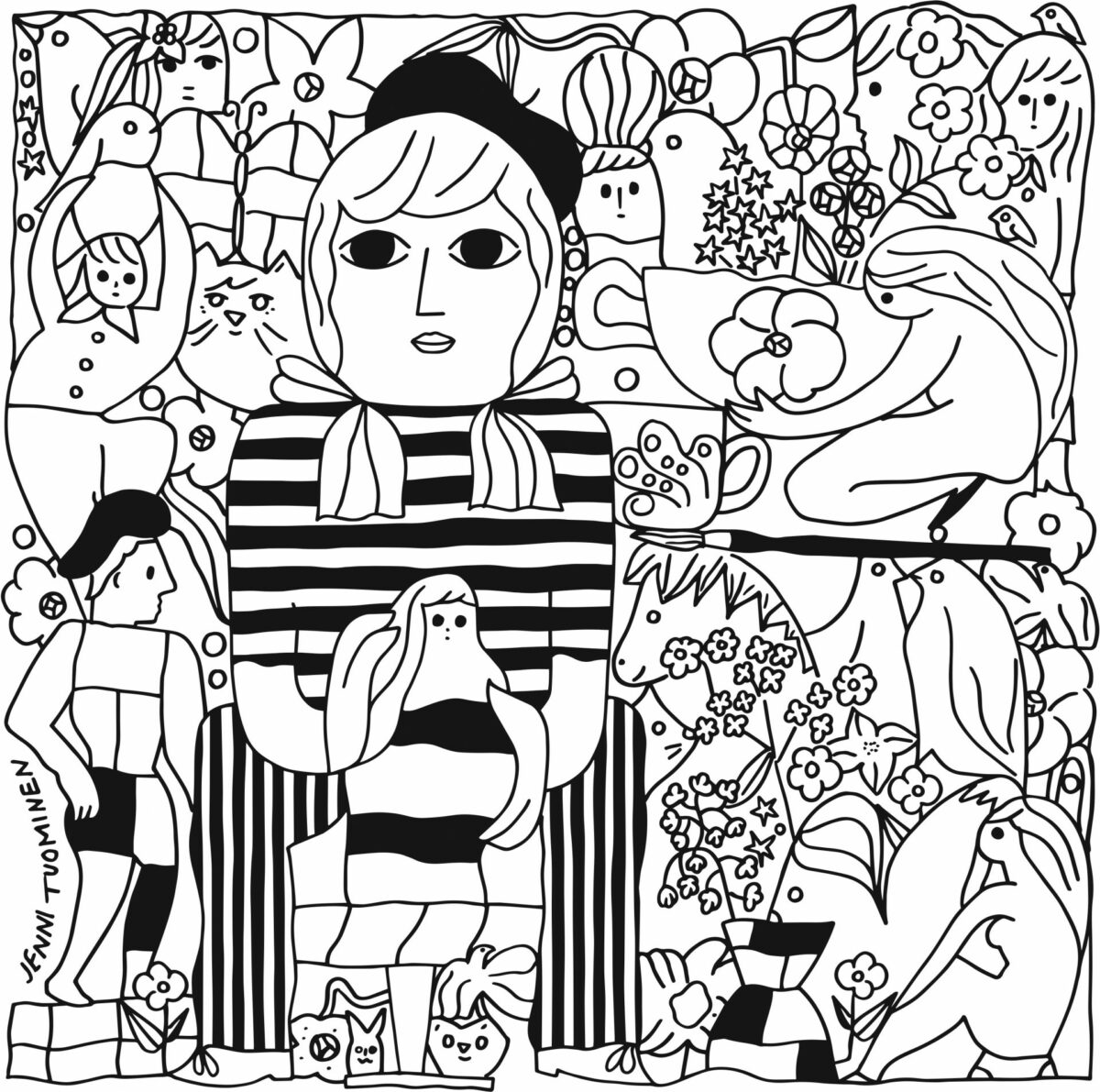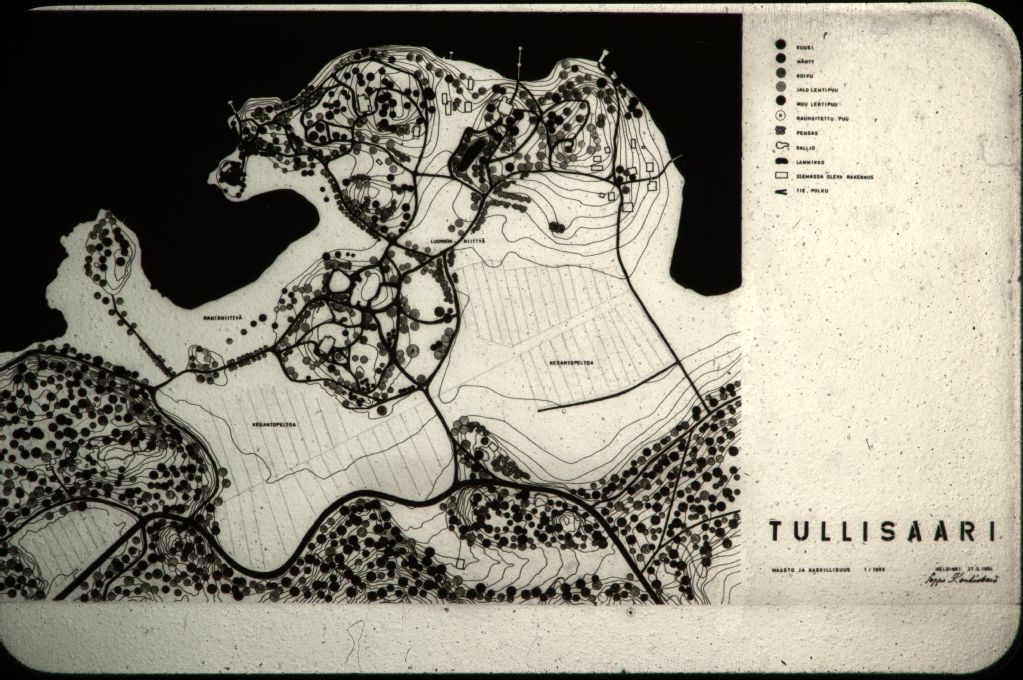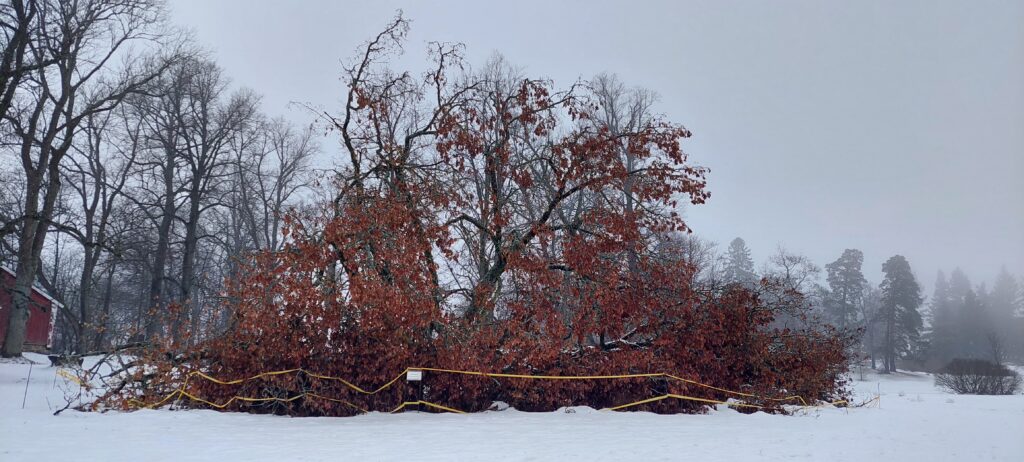The listening experience is not only a geographical teleportation device but a scalar one. You become reduced in size too.
Matt
June 2022
June 2022 marked the third collective gathering with Bee Company. In the summer of 2021 Bee Company initially joined together in the beautiful surroundings of the Saari Residence. In that time we explored each of our individual creative practices, methodologies and conceptual frameworks. Our second gathering took place within Tullisaari Park in the winter of 2022. During this period we considered possibilities for how we might be able to create a public tour of the park which integrated our individual practices and methodologies in an event format. The third and most recent gathering was—for me at least—an opportunity to continue an ongoing interest in exploring our individual methodologies, but also to begin to share some of our practice and interests with the public audience of Tullisaari Park.
On PQ 2023
In March 2022 we were offered to be the official representation of Finland in the forthcoming Exhibition of Countries and Regions of PQ2023 (Prague Quadrennial) festival of performance design. Since this announcement was made our collective activity has started to become shaped by the needs to produce an output corresponding to PQ2023. It has become somewhat contra to our—up to this point—iterative collective process. Our direction has started to feel in tension between imagining this concrete output of a major international festival with pavilion style exhibitions against our characteristically tempered collective gatherings and their slow collection of tributaries; ideas which branch off and reconvene with different forms. A question for the midsummer open park residency was to engage with this tension between remaining in our fluid and exploratory stage of our collective work, whilst also understanding the need to do our work –and Finland!—justice within the context of an international artistic/performance design exhibition, with pavilions, competition, prizes, pride, and artistic statements all at stake.
For the remainder of this reflective passage on my personal experience of our open residency in Tullisaari Park, I will think about my personal experience of public engagement within the project. I am interested in thinking about the possible implications of this time spent together in the park and what it might mean (if anything) for our proposal and contribution towards a festival happening 2,000km and over a year away.
RARE
The PQ 2023 theme is the RARE: art springing out of ideas, materials, artistic approaches, and design practices that connect to the human level from within your environment, with its genius loci and unique situation. Prague Quadrennial call on performance designers, scenographers, and performance practitioners to use their RARE imagination and creativity to help us envision what the world and theatre could look like in the post-pandemic future.
This was the opening of the curatorial statement for PQ 2023 in its call for applicants. I have begun to think of Bee Company as an almost nomadic collective. It is a mesh-group which forms in different configurations around the locus of Tullisaari Park where Ina cares for and maintains four honeybee hives.
The ‘roaring 1920s’ are often considered as an era of great exuberance and excess across Europe and US. Recovery from the First World War and subsequent Spanish Flu pandemic was under way and The League of Nations promised security, collaboration and prosperity amongst the member nations including Finland, who had itself become an independent republic in 1917. This boom, captured magnificently by the scenes presented in F. Scott Fitzgerald’s 1925 novel The Great Gatsby suggests a ‘20s of huge celebrations, parties, debauchery and entertainment. During the height of the pandemic, commentators speculated as to whether a return to a world similar to the 1920s was due. Would people be keen to ‘get out there’ and ‘party hard’, entertain and be entertained? Would the post-pandemic performance and theatre worlds resonate to a demand for exuberance, with huge shows, lights, networks, sounds, big! Bigger! Biggest!? I am also conscious that the 1920s came to a brutal climax with the 1929 Wall Street Crash. It turned out that the excess was completely unaffordable and that people had been massively over speculating based on nothing (a typical condition that recurs time and time again under capitalism).
In 2022 the global economy is on the brink and across the West inflation is nearing all-time highs in many nations, strike action is becoming increasingly frequent and the cost of living is soaring. At the same time, profits for those at the top of shareholder stakes are also at ridiculous highs. How can this be sustained? If the markets won’t crash, do workers need to revolt and force their hand?
Listening as episteme; a knowledge gatherer, structurer, codifier, and ephemerata.
The conditions of Western economics and global markets under capitalism are also imbricated within the environmental impacts it continues to contribute towards. The summer of 2022 has seen unprecedented levels of climate catastrophes, global heatwaves, droughts and fires have broken out in areas often affected, but also new areas which have not suffered before. Simultaneously a war on European land has broken out which not only has impacted the lives and wellbeing of those within the borders whose lives are threatened on a daily basis, but also the ramifications the war is having upon food and fuel supplies across the world.
It all feels incredibly heavy. It all feels like a significant weight to load upon the shoulders of six creative practitioners and four honey bee hives. Should Bee Company be responding to this global crisis? At what level can we engage with it if we do?
Our mission has always been to reflect on the precarity of the creative practitioner within the conditions of western capitalism where funding for the arts is being constantly slashed, and at risk and positions remain always temporary, precarious and subject to the goodwill of wealthy benefactors. How do we support each other? How do we support ourselves? How might we explore our practices and these conditions together, and might the world of beekeeping/the lifeworld of honeybees act as inspiration for the way ahead?
Tullisaari Park
In the park, we met each day for a four days. We would share activities together, reconnect, discuss our feelings around the presentation of Bee Company to public audiences; one audience being that of our open event in the park at the end of the week and the other an international performance art and design crowd at PQ 2023.
Each day we wore beekeeper outfits that Ingvill had bought us. They helped us assume a formal presence, a formal sense of purpose and cohesiveness as a collective. It was also really fun to be in a costume and to see the confused looks of members of the public in the park when they saw a fleet of beekeepers marching. They would look around to see if there were bees somewhere, only to be left bemused that there almost always weren’t.
My work is primarily interested in listening. I am interested in listening as an individual artistic practice, listening as a technique, method, and methodology towards approaching and understanding the world. Listening as episteme; a knowledge gatherer, structurer, codifier, and ephemerata. Spending time with conscientious thinkers, speakers and listeners is a great pleasure. We don’t just listen with our ears; through haptic tactility and proprioception, we listen with our bodies too. And on our first day, we collectively joined and explored our bodies as resonators in a movement practice set by Suvi. We each responded to the fine adjustments sensed between each other’s bodies in what became a quiet dance. No music could be heard but the bodily rhythms and pulses felt, the breathing, steps, and rustling of costumes heard.
Listening with bees
On the final day we presented some ‘experiences’ to the public park. I was a bit isolated from the rest of the group who were located in different areas of the park tending to other activities. Dressed in beekeeper suit, I was based on a path which is one of the main entrances into the park. It is also where two of Bee Company’s hives are (down a hilly bank, in a dense field).
The two hives included one Farrar hive and one Top Bar hive. A Farrar hive is a vertically modular beehive with hung frames that bees use to build comb and store honey. They are a typical and familiar aesthetic ‘box’ design that are often what is thought of when one thinks of a beehive. They are often used in modern professional beekeeping. Within this hive lives a group of Italian bees, Apis mellifera ligustica who are a popular subspecies of honeybee.
A Top bar hive is one of the oldest and most commonly used hive style in the world and looks a bit like a wooden barbecue. In top bar hives bees build their honeycombs without waxfoundation. They are less convenient for the beekeeper to manage and take care in comparison to the modular style. Within the top bar hive, a new swarm of Carniolan honey bee (Apis mellifera carnica), a subspecies typically known in the central European region, and typical in Croatia, was collected from a woman’s garden by Ina only a few weeks prior. Typically after swarming and being brought into a new hive, honeybees are incredibly active as they bring in food and resource to build out their new home and consolidate their colony. This hive was no exception. It was incredibly active.
With the assistance and consent of our beekeeper Ina, I moved two DPA 4060 microphones in a spaced omnidirectional stereo configuration along with a Sennheiser MKH416 shotgun microphone. The microphones were aimed towards the entry door to the top bar hive at a distance that would not obstruct the entrance. We laid cabling up the bank to a listening station that we set up with two small stools and attached the cables to a Sound Devices Mix-Pre 6 Field Recorder and connected a pair of headphones.
We spent some time listening to different balances between the two microphone setups and found a blend between the two, with the DPAs having a 120Hz high pass filter set on them which allowed their stereo qualities to emerge whilst the mono Sennheiser microphone offered a closeness and clarity to overall sound. My first impressions were that the bees sounded incredibly busy, even at 6pm in the evening.
What followed for the next two hours was really quite incredible. In my beekeeper suit. I would say hello to passers-by, inform them that I was listening to the sounds from a new bee hive recently introduced to the park, and invited them to join me and take a listen. I would then tell them about Bee Company, that I had friends/colleagues wearing beekeeper overalls elsewhere in the park, and encouraged them to find them too. Collectively we aimed to engage with the public and invite them to consider bee ecologies within the park. Most of the people lived nearby, many commented on having seen the hives and wondered what was happening with them. Some of the folk who stopped and listened had also kept bees at various times in the past. One young man, perhaps in his late teens, who was running past and sweating heavily, surprisingly stopped and took a long five minutes catching his breath whilst listening with deep concentration to the hives. He asked many questions about the bees. I felt a bit of an imposter. Whilst I was in a beekeeper suit, listening to bees and inviting people to take part, I am not an apiarist and my specialist knowledge of bees feels quite limited. Over the last two years of engaging in Bee Company I have definitely developed some foundation knowledge in bees that I hope make it possible for me to give accurate information when asked on the basics though.
Another person stopped and began to ask quite directly as to whether I was selling the honey or not. After listening to the bees through the headphones for a few minutes, we then began to engage into a fascinating conversation about whether honeybees are affected by the introduction of 5G wireless electromagnetic signals. The person explained how they were a smartphone user but they were cautious about new wireless signal technologies and what they might be capable of doing to small insect species such as bees. There is a great deal of research produced in particular over the past decade about the effects of electromagnetic signals on honey bees which continue to be inconclusive.
Scale effects of amplified close listening
When I listen to close microphone amplified sounds of honey bee hives, I am often at first quite shocked and slightly disturbed. The sense of being deeply immersed inside a world or vortex of honeybees is quite worrying and arguably counter-evolutionary. However, as I spend time in the intensity, becoming accustomed to it, I begin to be quite entranced and fascinated by the activity that thousands of individuals within a single species, in a single hive, can come together with a single purpose. It is not a sound that matches a harmonic scale. It doesn’t flow with sustained rhythm and meter. But the sound, as chaotic as it is, represents a community finding its way collectively through messy interchanges but ultimately working towards one ultimate goal, flourishing survival of the colony. I think this is something that dawns on people as they listen to a bee hive too. Often they are initially shocked in their response due to the intensity. After all, from the bank you can see that there are hives at the bottom of the hill a few metres away, but you cannot hear bees in any great number. The headphone experience transports the listener down the hill and to the entrance of a huge city. The listening experience is not only a geographical teleportation device but a scalar one. You become reduced in size. Reconfigured at honeybee scale, you become immersed, shocked, terrified and equally enthralled and tranced by the industry of the colony. You can temporarily inhabit the world of those bees, eyes closed, perched upon a stool. Eyes open, you achieve embodied dissonance which allows you to be at once in the hive, part of the collective, and simultaneously a surveyor of the wider scene. It is a moment where you can become aware of being truly part of something bigger than yourself. This is a rare moment for the observer. An encounter that challenges and encourages an appreciation of scale, of energy, industry and collective endeavour that transcends the values of capitalism.
A moment to listen to an encounter that fosters a scalar and temporal shift is my personal rare vision for the performance of Bee Company.
